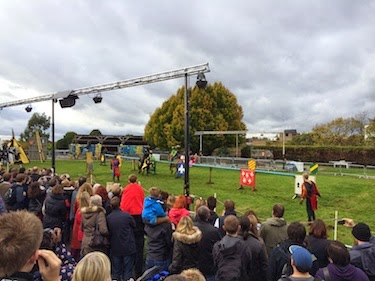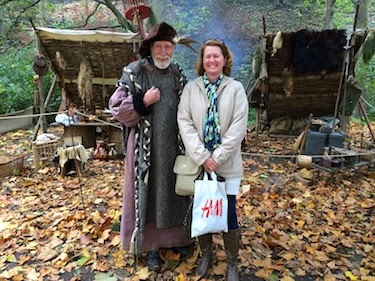 |
| A Joust! |
One of the questions this nomadic empty-nest travel couple is asked by friends and family back home is whether we ever encounter language problems or curious differences during our travels. The answer, in general, is no, we don’t encounter huge language barriers: most of Europe speaks English, even if only as their second language, plus we’ve gotten really good at “practical charades” (don’t underestimate the power of universal sign language). Naturally there’s some effort required at communicating, even amongst our British brethren, as we blogged about earlier in this adventure, and it’s an enjoyable pastime of ours here in the UK to make note of some of those differences, some of their interesting applications of our common language.
For tangential example, there is, not too far from where we’re staying in Nottinghamshire, a road sign bearing the warning “Adverse Camber”; in the states we’d just slap up a sign that says “Blind Curve”, but that just isn’t descriptive enough for the English who assume that you know an adverse camber will result in, of course, a blind curve. The English version, therefore, gives you a great deal more information about the slope and angle and adversity of the curve, usable or not. That it renders the warning incomprehensible to most of the English-speaking world is immaterial.
The city of Nottingham, on our first weekend in the area, held their annual “Robin Hood Pageant”. If I described for you the young man and young woman wearing grand period costumes who were respectively crowned Robin Hood and Maid Marian–and made a wickedly sarcastic comment about Honey Boo Boo–you (our American readers) would probably just plod along with me, agreeably. But “pageant” here is about as far from the sorts of “pageants” we have back home as possible.
In this case it was more of a Robin Hood festival: a two-day event of activities, displays, costumes, shows, food, crafts, and shopping, completely lacking, I should point out, of any sort of pageant-like contests. Out of curiosity, I Googled for Robin Hood Festival and found several other English events so-named, so I suppose Nottingham’s use of Robin Hood Pageant was more for marketing and competitive differentiation than for a deeper, more English, meaning of the word.
But in all other regards, it was very much the same as a festival we’d have at home. It was held on the grounds of the Nottingham Castle, itself worth a mention (coming paragraph). A stadium area was set up in which there were jousting displays; while they were no doubt choreographed by a professional group called the “Knights of Nottingham” (complete with giant, though anachronistic, tractor trailer, aka an “artic” to our British audience), it was still an impressive show, complete with splintering lances, sparks flying from swords, and much falling from horses. The crowd favorite, naturally, and I suspect perennially, was the padded Friar Tuck, sloshing beer from his tankard and unwittingly riding his horse backwards from time to time.
There were tents setup with people wearing period costumes and selling interesting crafts, food trucks, costumed characters wandering about, and sword fighting lessons and archery ranges. There are never archery ranges on “Toddlers and Tiaras”, but it might make the show a whole lot more interesting: “Now here’s your arrow, Little Tiffany, just aim at the judge you really don’t like…”
 |
| “Sherwood Forest” |
The pageant was held around the Nottingham Castle, and admission to the castle and its museum was included in the price of admission. The whole complex is situated on a cliff called “Castle Rock”, and with commanding views of the countryside it’s easy to see why someone would have built a fortification here to begin with. Today’s building is relatively modern, built in the late 1800’s to be the museum it still is. Before that it was a Duke’s mansion that had been burned down by rioters, a seemingly common problem in England. Both of the two most modern structures would be better described as a mansion; you would have to go back to the building before that–the outline of which is the only thing inherited by today’s building–to feel good about calling it a castle.
Today’s castle-mansion is a museum that houses an eclectic collection of artifacts from the local area, from some interesting medieval alabaster carvings to some decorative arts pieces. The collection most worth seeing in the museum is the regimental museum of the Sherwood Foresters, assuming of course you have an interest in storied military companies. Otherwise, just stay outside, and if you’re lucky you’ll spot a bard or a minstrel or a knight or a toddler taking out a score-stingy judge.
 |
| Can You Tell Where She Shops? |






